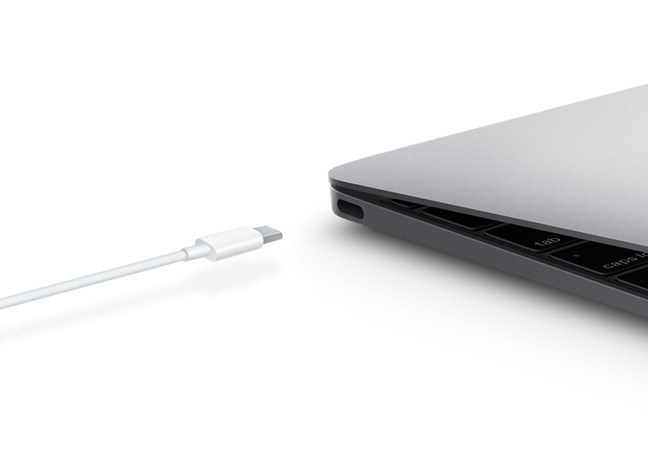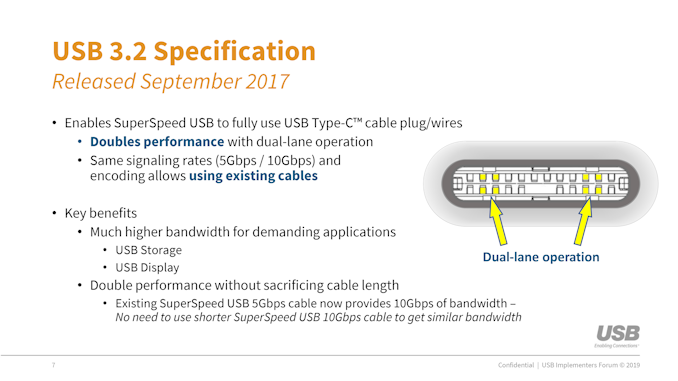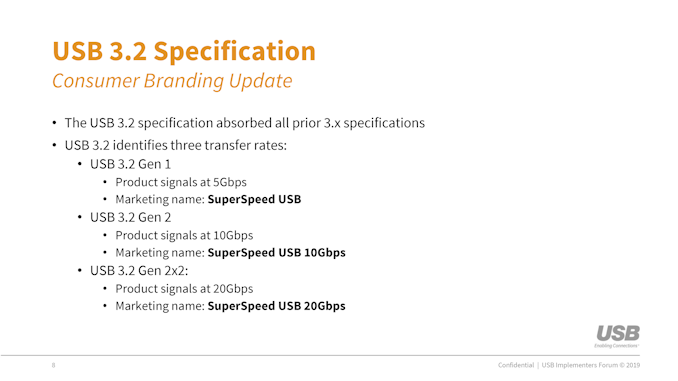USB 3.2 at 20 Gb/s Coming to High-End Desktops This Year
by Anton Shilov on February 26, 2019 1:00 PM EST- Posted in
- Peripherals
- Trade Shows
- USB-C
- USB
- ASMedia
- USB 3.2
- MWC 2019
- Synopsys

Since mid-2017 we've been talking about the impending arrival of USB 3.2, the next version of the USB Implementers Forum's ubiquitous standard for connecting external devices. With 3.2 serving as both an upgrade to the feature set and a physical layer tweak to provide more bandwidth, according to the USB-IF at MWC 2019, the technology will finally come to fruition this year.
According to the organization that sets the standards for the USB interface, discrete USB 3.2 controllers capable of supporting the standard's new 20 Gb/s Type-C mode will be available this year. Being a specification-setting group, the USB Implementers Forum does not name companies that develop actual chips. But given the limited number of companies that develop standalone USB controllers, the names of the suspects are pretty well known.
Since discrete USB controllers are used mostly by high-performance desktop systems, we're likely to see the first USB 3.2 chips to land on high-end motherboards first. In which case we could see motherboard venders showing off product sometimes this summer, or maybe a bit later. Meanwhile peripherals will likely lag a bit for compatibility testing and the like, in which case we'd start seeing them in 2020.
Though technically only a point upgrade for the USB standard, USB 3.2 includes multiple enhancements for the standard in terms of bandwidth, as well as changes to how the standard is branded. In terms of bandwidth, USB 3.2 introduces the ability to use two high-speed USB Type-C Tx/Rx channels – the so-called x2 mode – to get 20 Gbps maximum throughput on a Type-C cable. The technology retains the USB 3.1 physical layer data rates and encoding techniques (SuperSpeed and SuperSpeed+), so while bonding two channels is new, how those individual channels work at a low-level is not.
Meanwhile, USB 3.2 branding will be absorbing the earlier USB 3.0/3.1 branding, as the overriding USB 3.x standard continues to evolve separately of the underlying SuperSpeed encoding technique. As USB 3.2 hosts and devices roll out on the market, we’ll see the branding switch over to USB 3.2 Gen 1 (5Gbps SuperSpeed), USB 3.2 Gen 2 (10Gbps SuperSpeed+), and USB 3.2 Gen2x2 (2x10Gbps SuperSpeed+). So while all future products will be 3.2, they won't necessarily support the higher 10Gbps and 20Gbps data rates. Those decisions are up to the device manufacturer, especially as not all devices need the higher speed modes and the increased build costs that come with them.
Related Reading:
- ASMedia Demos USB 3.2 Gen 2x2 PHY, USB 3.2 Controller Due in 2019
- USB 3.2 Update to Bring 20 Gbps Bandwidth: USB 3.1 Type-C Cables Compulsory
- Cosemi Launches USB 3.1 Gen 2 Hybrid Active Optical Cable: Up to 50 Meters of USB
- Cypress and Zhaoxin Have USB 3.1 Gen 2 USB Controllers
Source: USB Implementers Forum












62 Comments
View All Comments
ikjadoon - Tuesday, February 26, 2019 - link
Let's remind everyone of all the possible USB ports that will be in *shipping products* this year:USB 3.1 Gen 1
USB 3.1 Gen 2
USB 3.2 Gen 1
USB 3.2 Gen 2
USB 3.2 Gen 2x2
And not a single one of those ports will be labeled as such on any device.
Stop bloody calling them 'generations' because they're released all at once. Maybe they should've used:
USB 3 = 5 Gbps
USB 3.1 = 10 Gbps
USB 3.2 = 20 Gbps
This sort of needless renaming of older products serves only one purpose: confusing consumers enough that they get suckered into thinking their USB is now outdated and any company who sells the "newer" version is actually offering them more value.
Talk about the corporate version of regulatory capture...only a greedy, pathetic OEM could've said, "Hey. I don't like my ports being labelled USB 3 on this $400 laptop. That feels old, ya know? Can you just rename it USB 3.2 so my consumers overpay versus an older laptop that 'only' has USB 3.1?"
eddman - Tuesday, February 26, 2019 - link
The USB 3's naming scheme is simply baffling. Is there any technical reason behind it or, as you stated, it is simply to satisfy the OEMs?@Anandtech's writers
Perhaps an interview with USB-IF is in order?
twelvebore - Tuesday, February 26, 2019 - link
They should take a leaf out of the book of the HDMI consortium. Their naming scheme isn't confusing at all.Oh, wait... the other thing.
DigitalFreak - Tuesday, February 26, 2019 - link
I would have zero problems with HDMI if they didn't make most of the features optional.DigitalFreak - Tuesday, February 26, 2019 - link
USB 3.1 Gen1 = USB 3.0USB 3.2 Gen1 = USB 3.0
USB 3.2 Gen2 = USB 3.1 Gen2
All it is is a rename.
Ryan Smith - Tuesday, February 26, 2019 - link
"The USB 3's naming scheme is simply baffling. Is there any technical reason behind it or, as you stated, it is simply to satisfy the OEMs?"There actually is a technical reason. The overarching USB 3.x feature specification and the underlying protocol specifications are evolving separately. Features like authentication, Power Delivery 3.x, simultaneous audio + charging, etc, have all been added to USB 3.x at various points in time, and none of them require changing the low-level protocol. Which is to say, they can be made available on newer 5Gbps ports.
This is why the version number is being revved. You'll now have devices that support the latest USB features, and can operate at 5, 10, or 20Gbps depending on how much bandwidth the device has been designed to utilize.
eddman - Wednesday, February 27, 2019 - link
I see. So all those media reports back then about renaming USB 3.0 to 3.1 gen 1 were actually wrong then.IMO they could have used a better branding scheme, say USB 3.2 G5, G10, G20 (or something similar) instead of a vauge gen number.
Ryan Smith - Wednesday, February 27, 2019 - link
"So all those media reports back then about renaming USB 3.0 to 3.1 gen 1 were actually wrong then."Basically, yeah. USB 3.0 equipment is still USB 3.0 equipment. However if you submit any new SuperSpeed (5Gbps) devices for testing, it needs to adhere to the USB 3.2 spec.
0siris - Wednesday, February 27, 2019 - link
1 Average Joe wants to know the bit rate.2 USB-IF wants to "communicate the feature specification".
3 Manufacturers want to make the labelling as confusing as possible so they can legally label low-performance ports in a manner suggesting they are high-performance ports.
I think it's safe to say that the current moronic concoction isn't achieving #1 or #2. #1 is a failure because you can't tell if the port is 5, 10 or 20 Gb/s(and sometimes even Thunderbolt) from the port type or port label. #2 is a failure because 95% of the time the ports are unlabelled or labelled with a generic USB symbol. So if you're failing at both, why not just award the version naming scheme to the bit rate and the suffixes to the feature specification? At least you'd be able to infer ONE of them from the name then, instead of neither as it is now.
#3 however seems to be a resounding success, I wonder why that is? It's almost as if the companies who make up the USB-IF are the same as those manufacturers I mentioned earlier...
vincentyu1130 - Tuesday, February 26, 2019 - link
The bureaucracy is going to kill the organization.